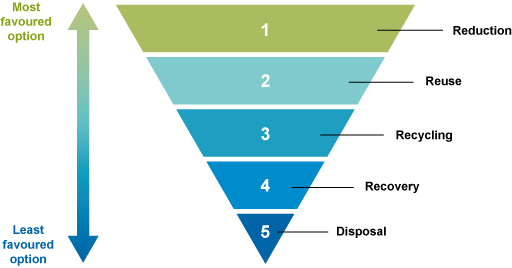Use 'Print preview' to check the number of pages and printer settings.
Print functionality varies between browsers.
Printable page generated Saturday, 29 November 2025, 5:10 PM
Study Session 1 Introduction to Sanitation and Waste Management
Introduction
All humans produce wastes of various types; for example, urine and faeces, wastes from washing and cooking, and solid wastes produced at home and in workplaces, schools, hospitals and other public buildings. All these wastes need to be controlled and managed for the benefit of people and the environment that they live in. In urban areas where people live close together and space can be limited, managing these wastes is a difficult problem.
In this study session we will introduce you to the main topics and issues related to sanitation and waste management, which will be discussed in detail in the rest of this Module.
Learning Outcomes for Study Session 1
When you have studied this session, you should be able to:
1.1 Define and use correctly all of the key words printed in bold. (SAQs 1.1, 1.2 and 1.3)
1.2 Describe the similarities and differences between ‘sanitation’ and ‘waste management’. (SAQ 1.2)
1.3 Describe the sanitation ladder and the waste hierarchy. (SAQ 1.3)
1.4 Describe the particular features of urban areas that influence sanitation and waste management. (SAQ 1.4)
1.5 Understand the current status of sanitation and waste management in Ethiopia and the policies that exist to improve the situation. (SAQ 1.5)
1.1 What are sanitation and waste management?
We can think of sanitation as the prevention of human contact with wastes, or as the provision of facilities and services for the safe disposal of human faeces and urine. More formally, the World Health Organization (WHO, n.d.) defines sanitation as:
the provision of facilities and services for the safe disposal of human urine and faeces, the maintenance of hygienic conditions, through services such as garbage collection and wastewater disposal.
By ‘facilities’, we mean the structures that are used to provide sanitation. This ranges from latrines and toilets, the system for collecting the excreta from latrines, through to sewage treatment systems. By ‘services’ we mean the whole scheme for providing sanitation; providing facilities, maintaining them, treating the wastes from them and organising finance and payments.
The WHO (n.d.) goes on to state that:
inadequate sanitation is a major cause of disease world-wide and improving sanitation is known to have a significant beneficial impact on health both in households and across communities.
Waste management is defined in the European Union’s Waste Framework Directive (European Commission, 2008) as:
the collection, transport, recovery and disposal of waste, including the supervision of such operations and the after-care of disposal sites, and including actions taken as a dealer or broker.
The two terms – sanitation and waste management – both refer to waste, but sanitation is primarily concerned with liquid waste and waste management is primarily concerned with solid waste. Liquid wastes are any wastes in a liquid form such as wastewater and sewage. Faeces and the contents of pit latrines and septic tanks are also classed as liquid wastes. Solid wastes are anything in solid form that is discarded as unwanted.
You will find that, in practice, sanitation and waste management are used in ways that overlap and some organisations include solid waste management as part of sanitation. Throughout this Module, we will be using the following definitions:
- Sanitation means preventing people from coming into contact with wastes by providing facilities and services for the treatment and disposal of human excreta and other liquid wastes produced in homes, workplaces and public buildings.
- Waste management is the collection, treatment and disposal of solid wastes produced in the home, workplace and public buildings.
Some of the consequences of a lack of waste management and sanitation can be seen in Figures 1.1 and 1.2.
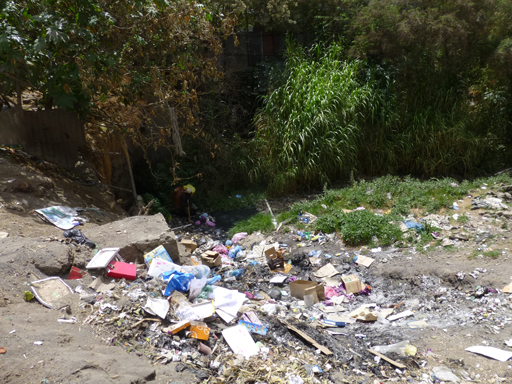
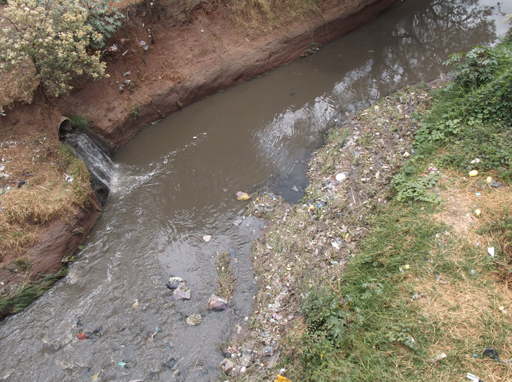
Although sanitation and waste management address different issues using different techniques, they have a number of features in common. For example, they both:
- deal with wastes
- are concerned with safeguarding human health and preventing disease
- cause major problems if not done correctly
- help to reduce environmental pollution (introduction into the environment of substances liable to cause harm)
- need to be paid for by the users, the city authorities or the government.
1.2 Types of liquid and solid waste
The aim of this section is to introduce the different types of solid and liquid wastes and to clarify what we mean by the term ‘waste’. The Basel Convention (an international agreement on the exporting of hazardous waste) states that (UNEP, 2011):
‘wastes’ are substances or objects which are disposed of or are intended to be disposed of or are required to be disposed of by the provisions of national law.
You should note that this definition includes both solids and liquids. Solid and liquid wastes are usually transported and treated in different ways, so in this Module we will consider the two wastes separately. Note that all human excreta (urine and faeces) are considered to be liquid wastes.
1.2.1 Types of liquid waste
The types and characteristics of liquid wastes are discussed in Study Session 4, but a useful general classification of domestic liquid waste is as follows:
- Blackwater – is wastewater that contains or consists of urine and faeces. It contains pathogens (disease-causing agents).
- Greywater, or sullage, is wastewater from human washing and bathing, kitchen sinks, clothes washing, etc. It does not contain excreta.
- Stormwater (or surface run-off or rainwater run-off) is wastewater that flows on the surface of the land to join streams. Note that this is considered as wastewater because it contains many different contaminants.
- Sewage is a combination of wastewater coming from any of the above sources and flows in underground sewers or open ditches.
- Excreta is a combination of urine and faeces.
1.2.2 Types of solid waste
There are different ways of classifying solid wastes according to the source of generation or the nature of the waste. Solid waste can be categorised as follows:
- Residential waste: from households and residential areas. This is sometimes called household waste. Garbage, rubbish, trash and refuse are other terms for residential waste.
- Commercial waste: from businesses such as food and drink establishments, shops, etc.
- Industrial waste: from various types of industrial processes, e.g. food processing, paper manufacture, manufacture of chemicals and metal processing.
- Institutional waste: from public and government institutions, e.g. offices, religious institutions, schools, universities, etc. This is similar to residential and commercial waste in composition.
- Municipal waste (or municipal solid waste) covers all the above wastes produced in an urban area. It is similar in composition to residential waste but excludes some industrial wastes.
- Healthcare waste: any solid waste produced in hospitals, clinics, health posts and other health facilities.
- Agricultural waste: waste that comes from farming.
- Waste from open areas: street sweepings, contents of roadside dustbins, ditches and other public places.
- Construction and demolitionwaste: from various types of building and demolition activities in urban areas.
- Electronic and electrical waste (e-waste): wastes generated from used electronic devices and household appliances.
There are other ways of classifying wastes and we will look at these in Study Session 7.
1.3 The sanitation ladder and waste hierarchy
Generally speaking, all countries are aiming to improve their standards of sanitation and waste management, and have many policies and regulations to try and achieve these improvements. We will look at some of these regulations in later study sessions, but the sanitation ladder and the waste hierarchy provide an excellent summary of these aims.
1.3.1 The sanitation ladder
The sanitation ladder provides a measure of progress towards the provision of adequate sanitation facilities for every household. The WHO/UNICEF Joint Monitoring Programme (JMP) version of the ladder is shown in Figure 1.3.
The lowest rung of the ladder is open defecation, where people without access to latrines or toilets deposit their faeces in open spaces. Unimproved facilities are one step above open defecation and include latrines that do not ensure the separation of faeces from humans. The next stage is shared facilities, which are facilities that would be classed as improved, but are shared by two or more households. At the top of the ladder are the improved facilities, where human contact with faeces is avoided. Different types of latrine facilities are discussed in Study Session 6.
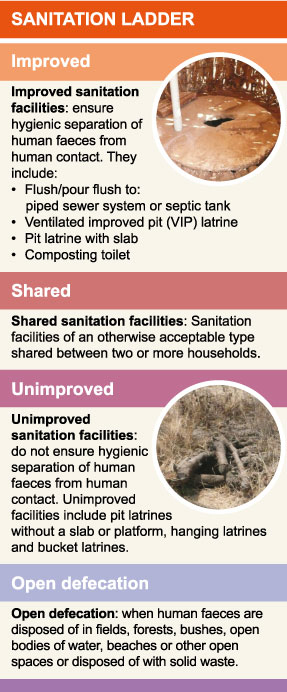
1.3.2 The waste hierarchy
The waste hierarchy is shown in Figure 1.4 and is discussed in Study Session 9. The hierarchy ranks the different ways of dealing with waste in order of desirability. At the top is waste reduction, which means not generating waste in the first place or minimising the amount of waste produced. Below that is waste reuse (for example, refilling a drinks bottle), followed by recycling (processing of wastes into new raw materials). A fourth option is the recovery of energy by burning or biological treatment. Disposal, ideally in a landfill site, is the final option for any wastes that cannot be dealt with in any other way. A landfill site is an area of land set aside for the final disposal of solid waste.
The top three stages of the hierarchy (reduction, reuse and recycling) are often referred to as the ‘3 Rs’, a term we will use throughout this Module.
What are some of the ways that you could reuse wastes at home.
Some suggestions are to:
- use empty food containers to store food that was bought loose
- refill plastic drinks bottles with water
- use clothes from your oldest child to dress younger children
- use worn-out clothes as cleaning cloths
- give books to friends when you have finished with them.
1.4 Sanitation and waste management in urban areas
Sanitation and waste management can cause problems in any community, regardless of its size. In urban areas, where people live close together these problems can have a much greater effect on people’s health and on their surroundings. The following sections explore some of these issues.
1.4.1 The trend of urbanisation
Most of the population in the world lives in urban areas. The United Nations Department of Economic and Social Affairs (2014) predicts that between 2014 and 2050 the global urban population will rise from 3.9 billion to 6.4 billion people, and that about 90% of this increase will be in Asia and Africa. In Ethiopia, the proportion of people living in urban areas is still low, but the growth in urbanisation (the increase in the numbers of people living in urban areas) is greater than in many other countries, as shown in Figure 1.5.
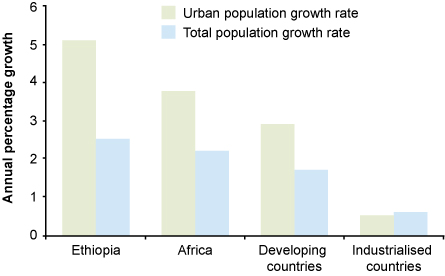
Explain in a few sentences what Figure 1.5 shows.
Figure 1.5 shows that the urban population of Ethiopia is growing at slightly more than 5% per year, which is more than twice the growth rate for the country as a whole. In Africa and other developing countries, the urban growth rate is much greater than the overall growth rate, but the difference is not as great as in Ethiopia. In contrast, the overall growth rate in industrialised countries is much lower than that of the developing world, and their urban growth rate is slightly lower than the overall growth rate.
Many cities in Ethiopia have developed in a rapid and unplanned way as people migrate to the cities seeking employment and a better life. This growth affects the provision of sanitation and waste management facilities and other infrastructure such as water supply, roads and electricity supplies. As an example, the city of Addis Ababa receives settlers from every corner of the country, many of whom live in illegal settlements without sanitary facilities and other infrastructure. As shown in Figure 1.5, statistical reports indicate that Ethiopia has a total population growth rate of 2.5% a year, with urban centres growing at a rate of 5.1% (Haddis et al., 2013). It is expected that by 2020, one in five Ethiopians will be living in urban areas, and by 2030, half of the country’s population will be living in urban centres (Teller et al., 2007).
As a result of rapid and unplanned urban growth, the sanitation problem of Addis Ababa is one of the worst in the country. For instance, 26% of the houses and the majority of slum-dwellers have no latrine facility, so they use rivers, ditches and open spaces (UN-Habitat, 2008).
Rapid urbanisation creates a number of health and environmental risks to the population (Bai et al., 2012) in addition to those caused by inadequate sanitation and waste management. These include:
- infectious diseases among crowded communities with substandard living conditions
- acute and chronic respiratory and other illnesses as a result of air pollution
- chronic and non-communicable diseases that are on the rise with unhealthy urban lifestyles (physical inactivity, unhealthy diets, tobacco smoking, and the harmful use of alcohol)
- injuries resulting from motor vehicle collisions, violence and crime
- health risks related to climate change, such as heat stress and changed patterns of infectious disease, which are considered to be one of the biggest health risks in the twenty-first century.
In the next section we will look at some of these challenges in more detail.
1.4.2 Environmental challenges
Urbanisation can have a major effect on the environment in the following areas.
Challenges emerging from rural-urban interaction
Urban centres are usually surrounded by rural communities and the two areas depend on each other to supply many of their needs. Urban areas depend on the rural areas to provide food, fuel and construction materials. In return, the rural community depends on urban areas to supply employment, commercial products, advanced healthcare provision, education and equipment, machinery, and other industrial outputs. Having said this, problems may arise when there is a large temporary influx of people from the rural to the urban areas. Examples include:
- the increased demand for sanitation facilities in the area around a city market
- the manure generated by animals that are brought for sale or used for transport (Figure 1.6)
- the congestion caused by the number of people and animals using the roads.
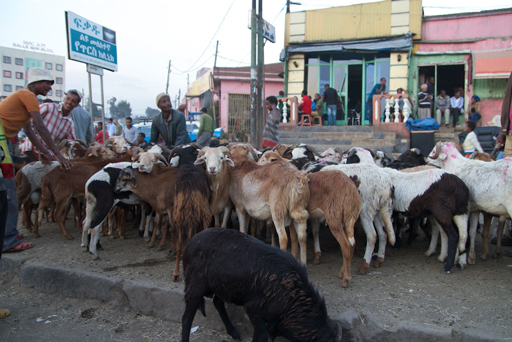
Challenges emerging from the urban situation
Even without the influxes from rural areas, urban centres are congested and crowded. They have often grown without any planning, so the problems arising from the lack of sanitation, waste management and the other infrastructure mentioned above are present. Urban growth also means that there is an increase in the area of land covered with concrete and other hard surfaces.
Why would an increase in the area of land covered with concrete or other hard surface be a problem?
When rainwater falls on soil it will usually soak in. When it falls on concrete it runs off the surface and can cause flooding if the rainfall is heavy.
Urban development reduces the ability of the ground to absorb rainwater. In urban areas a high proportion of the ground is paved, which prevents the absorption of rainwater. Also, unplanned developments usually lack the drainage ditches or channels necessary to carry away surface waters. These two factors combine to create an increased risk of flooding and the outbreak of waterborne disease that can follow floods.
Challenges from industrial discharges
Most industries in developing countries discharge untreated or partially treated liquid wastes to sewers, where these are available, or to rivers, streams or ditches. Industries also release waste gases that may contain harmful substances and produce solid wastes that may contain hazardous materials (such as poisons, strong acids, infectious material, etc. that can cause harm to humans because of their properties). As a result, unregulated industries can harm human health and the environment in many ways.
Challenges from transport
We have already mentioned problems from traffic congestion, but the use of a large number of often badly maintained petrol- and diesel-fuelled cars, lorries and buses cause additional health problems. The exhaust gases from these vehicles contain fine particles, partly burned fuel and acidic substances that make breathing difficult and cause irritation of the lungs. While this is a problem for all people, it is much worse for the old, the very young and the ill, especially those with heart problems or who suffers from asthma.
1.4.3 Challenges to society
Increasing urbanisation puts pressures on society as a whole as well as on the environment. People who migrate to cities may become unemployed and then need to be provided for. This puts pressure on welfare provision and on the charities that provide assistance to the hungry and the homeless. Even people who have jobs find it difficult to find somewhere to live and may develop illegal unplanned settlements that affect the planning and service provision of the government sectors. These settlements also add to the city’s sanitation and waste problems.
The urban population requires daily supplies of food, fuel and other goods which can put pressure on the infrastructure needed to deliver and sell these goods. Once goods reach the end of their lives they become waste, increasing the pressure on the waste collection and treatment systems.
1.4.4 Challenges to administration
A growth in population creates more work for the city’s administration. If funds are not available to increase staff numbers to deal with this demand, problems will occur. In the case of sanitation and waste management, as well as services not being provided to the whole of the city, the additional workload can reduce the effectiveness of the governance of these programmes, which can result in lower standards and a poorer service for the entire city.
To deal with the problems of population growth, various organisations need to work together; for example, water, sanitation and health service providers, and non-governmental organisations (NGOs). When growth is rapid, these organisations can be overwhelmed and so coordination can break down. This may mean that in some cases, efforts are duplicated, and sometimes there will be gaps in addressing some aspects of the programme.
If public administration and regulation is already weak, the entire system can fail. In the absence of good regulation, standards of sanitation and waste provision can fall, increasing pressures in other areas such as health services.
1.5 The present state of sanitation in Ethiopia
The WHO/UNICEF Joint Monitoring Programme (JMP) collects and publishes data for water supply and sanitation for all the countries of the world. The JMP data for sanitation coverage in Ethiopia in 2012 is shown in Figure 1.7.
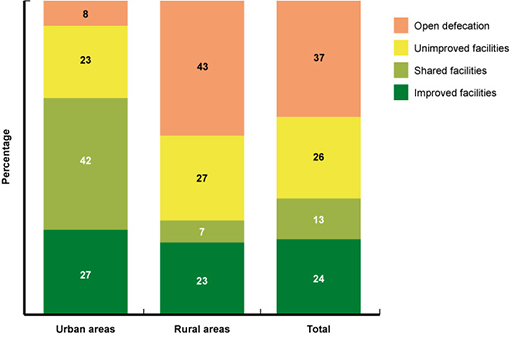
There has been a marked reduction in the practice of open defecation throughout Ethiopia in recent years, particularly in rural areas. This has been accompanied by a rise in the use of latrine facilities, but there is still a long way to go to eliminate open defecation and provide all people with access to improved facilities.
There is far less information available on solid waste management in Ethiopia than there is on sanitation. Outside Addis Ababa and other large cities, household waste is not collected and people tend to dispose of their waste in informal ‘open dumpsites’ where no records are kept. Organic materials (e.g. food, paper) eventually decompose, but other materials such as plastics accumulate or are blown around by the wind. Not surprisingly, there are no reliable figures for the amount of waste produced outside the main cities. In Addis Ababa, Basha (2007) estimated that around 2000 tons of waste were generated each day, around 75% of which was residential waste. Of this total:
- around 50–60% was collected by the city authority and taken to a local disposal site (Figure 1.8)
- 5–10% was recycled
- the remainder was either burned in open fires or dumped in open spaces, in watercourses or by the roadside.
Clearly, there is much progress to be made in collecting city waste and in finding a safe way of disposing of it.
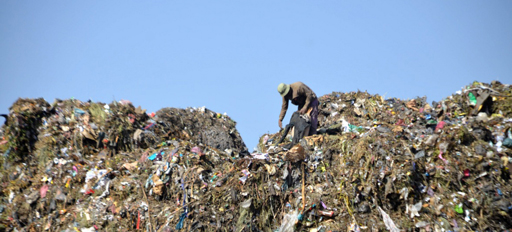
1.6 Policies, strategies and programmes
There are several national policies, strategies and programmes that are relevant to improving sanitation and hygiene in Ethiopia. Key policies are:
- The Health Policy (1993) which stresses that environmental health, occupational health and safeguarding the environment are priority issues.
- The Environmental Policy (1997) which promotes the use of renewable resources and recycling, and includes specific policies for industrial waste.
- The Water Resources Management Policy (1999) which describes the conservation, exploitation, use and protection of water resources.
These policies are reinforced by proclamations such as the Public Health Proclamation No. 200/2000, the Ethiopia Water Resources Management Proclamation No. 4/1995, and the Proclamation for the Establishment of the Ethiopian Environmental Protection Authority 2002. These proclamations provide support for regions, zones and woredas to develop a regulatory framework for their activity in the water, sanitation and hygiene sector.
The National Hygiene and Sanitation Strategy of 2005 (MoH, 2005) sets out a ‘sanitation vision’ for Ethiopia that is:
100% adoption of improved (household and institutional) sanitation and hygiene by each community which will contribute to better health, a safer, cleaner environment, and the socio-economic development of the country.
The goal of 100% access to basic sanitation has been carried forward to other policies and programmes, and is one of the targets of the new One WASH National Programme. (‘WASH’ stands for ‘water, sanitation and hygiene’.) The One WASH National Programme (OWNP), as the name suggests, is a single programme that combines the three interlinked components. Announced in 2013, it aims to address the WASH challenges in Ethiopia by adopting a unified and collaborative approach. The overall objective of the OWNP (FDRE, 2014) is:
to improve the health and well-being of communities in rural and urban areas in an equitable and sustainable manner by increasing access to water supply and sanitation and adoption of good hygiene practices.
The OWNP is unlike previous WASH programmes because it takes a sector-wide approach and involves the federal ministries of Water, Irrigation and Energy, Health, Education, and Finance and Development.
The four ministries have signed a memorandum of understanding (MoU) that sets out their roles and responsibilities. It therefore cuts across the traditional separation of responsibilities between ministries and has structures and processes designed to ensure closer cooperation and collaboration between all the stakeholders.
In comparison with the WASH sector, there are fewer policies and regulations relevant to solid waste. The Solid Waste Management Proclamation of 2007 has the objective to ‘enhance at all levels capacities to prevent the possible adverse impacts while creating economically and socially beneficial assets out of solid waste’ (FDRE, 2007). It sets out the obligation for urban administrations to create the right conditions to promote investment in solid waste management services and ensure the participation of local communities in the process of designing and implementing their solid waste management plans. It also sets out requirements for the supply and management of specific types of waste, including glass, tin cans, plastic bags, used tyres, food-related waste, household waste, and construction and demolition waste.
Summary of Study Session 1
In Study Session 1, you have learned that:
- ‘Sanitation’ and ‘waste management’ both refer to the appropriate management of waste to protect people and the environment. Sanitation generally focuses on liquid waste and waste management on solid waste.
- Liquid waste includes all types of wastewater and includes human excreta. Solid waste is any solid material discarded by people and is often classified according to its source.
- The ‘sanitation ladder’ illustrates the different types of sanitation provision in order of desirability.
- The waste hierarchy is a guide to the different ways of treating wastes from waste reduction (the best option) through to disposal (the worst option).
- The challenges of rapid and unplanned population growth and urbanisation in Ethiopia make it difficult to achieve acceptable levels of sanitation and waste management quickly.
- Sanitation in Ethiopia has shown significant improvement in recent years. There is less data for trends in waste management.
- There are several Ethiopian policies, strategies, proclamations and programmes that address sanitation and waste management issues.
Self-Assessment Questions (SAQs) for Study Session 1
Now that you have completed this study session, you can assess how well you have achieved its Learning Outcomes by answering these questions.
SAQ 1.1 (tests Learning Outcome 1.1)
On a piece of paper, write down each of the key words printed in bold in this study session. Cut the paper into strips with one word on each strip; fold them and put them in a bowl. Take a strip, read the word and write a definition in your notebook. Then check your definitions with those in the study session.
Answer
This game is intended to familiarise you with the terms you will meet again in subsequent study sessions. To find the right answer, you can check the definition written in your own words with that in the study session.
SAQ 1.2 (tests Learning Outcomes 1.1 and 1.2)
Arrange the following phrases under the correct heading in the table below.
- aims to protect people from disease
- management of e-waste
- mainly concerned with solid waste
- options are described as a ladder
- management of industrial wastes
- aims to prevent pollution
- mainly concerned with liquid waste
- options described as a hierarchy
- management of human excreta.
| Sanitation | Waste management | Both sanitation and waste management |
|
|
Answer
| Sanitation | Waste management | Both sanitation and waste management |
| Mainly concerned with liquid waste | Mainly concerned with solid waste | Aims to protect people from disease |
| Options are described as a ladder | Options described as a hierarchy | Aims to prevent pollution |
| Management of human excreta | Management of e-waste | Management of industrial wastes |
SAQ 1.3 (tests Learning Outcomes 1.1 and 1.3)
Rearrange the following into two separate lists, one in the correct order to form the sanitation ladder and the other in the correct order for the waste hierarchy. Put the best option at the top of your lists.
- pour flush toilet
- old cardboard box, flattened out, used as door mat
- defecating on waste ground
- broken wooden box used for firewood
- simple pit latrine with no ventilation or slab
- refilling a plastic bottle with cooking oil
Answer
The sequence for the sanitation ladder is:
- pour flush toilet (improved latrine)
- simple pit latrine with no ventilation or slab (unimproved latrine)
- defecating on waste ground (open defecation).
The sequence for the waste hierarchy is:
- refill plastic bottle with cooking oil (reuse)
- old cardboard box, flattened out, used as door mat (recycling)
- broken wooden box used for firewood (recovery – if the fire is used to keep warm or to cook food. If just burned without benefit then this is classed as disposal).
SAQ 1.4 (tests Learning Outcome 1.4)
Name three ways in which urbanisation creates challenges for effective sanitation and solid waste management.
Answer
There are several possible answers to this question, but the main challenges from urbanisation are caused by many people living very close together which puts pressure on all urban services. The rate of increase in population is very fast and the development of infrastructure for water supply and sanitation services cannot maintain the same pace of change. People arriving in cities often live in informal settlements which are developed without planning or control and lack essential facilities for the people who live there.
SAQ 1.5 (tests Learning Outcome 1.5)
There have been significant improvements in sanitation provision in Ethiopia in recent years, but progress is not so good for solid waste management. What reasons can you think of that might explain this difference?
Answer
There are several possible reasons, but you may have thought of the following:
- There is a well-known and direct link between poor sanitation, a lack of safe water, poor hygiene and human health. The impacts from poor solid waste management, however, are more environmental, social and economic and less directly linked to health so corrective actions are not always considered urgent.
- There is limited data available about current solid waste production which makes it more difficult to manage.
- There are many different policies and laws that relate to sanitation that have been in place for many years. Legislation about solid waste management is more recent and enforcement is not yet complete.
